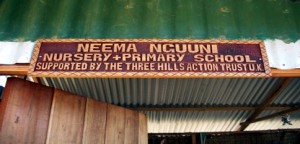The village of Neema Nguuni
Resting way out in the bush in Nguu Tatu, also known as the Three Hills, the village has none of the advantages that we take for granted. It is an hour’s drive North of Mombasa and west of Shanzu and Mtwapa (but almost all of the villagers must walk if they wish to visit the City). Where it is
This is a brief outline of what was the village when Marian and Jim first visited. We’ve managed to help change a lot but not without the enthusiastic community.
Before 2011 the village had neither a direct water supply nor electricity; no landline telephones nor internet (it could have radio if anyone could afford a radio!). The village has neither a restaurant nor a bar; there are no TVs; there is neither a cinema, nor sports club or snooker hall. The school was an open shack with almost no equipment.
What was and remains clear is that it is a thriving community of welcoming, friendly, very hardworking but struggling people.(Please see The enthusiastic community). They are led by the Chief, Oman Bakon, who encourages us as we try to help the villagers.
The houses to Westerners seem, and are, basic but they are made surprisingly comfortable. Here are two typical examples: one small and another larger example.
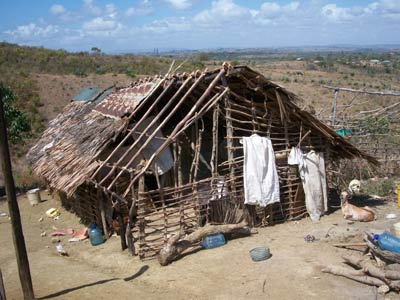
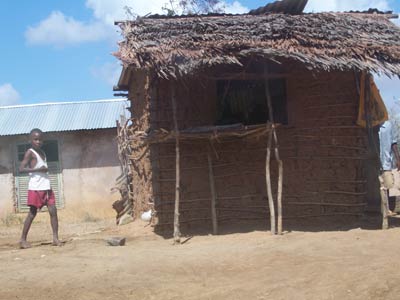
The nursery school
The nursery school is essential to help children gain basic literacy: without that (and a birth certificate), they can’t enter the state school system. The school was a shack with an earthen floor. It had over-age children who were being helped to gain basic literacy before being accepted into the state system; it had almost no facilities but did supply what for some was the only meal of the day: a simple bowl of maize-based gruel.
The school was badly damaged and almost washed away during a freak (and rare) storm and that was the trigger for Jim and Marian.
Marian and Jim on hearing of the damage decided to raise funds to build a new school and rescue the old building and that is the effective beginning of The Three Hills Action Trust.
Although we have a policy of not interfering, some ground-rules were agreed for the school children and parents including keeping the newly introduced uniforms clean etc. and a policy of “no late arrivals” at school (a child who is late, is sent home!).
When the school was built, it was recommended that we installed an appropriate sign!
Most of the children are in Catch 22: often they don’t get medical treatment because the local clinic is several miles away and a long walk. Without treatment they don’t get a medical card; without a medical card, it can be more difficult to get a birth certificate and without a birth certificate (and basic literacy) they won’t be admitted to the local state school… so we’ve been helping to sort that out.
On the lighter side, the children now have many of the facilities they need, not just “to learn” but to play, including a football, toys and skipping ropes.
They also now get a better diet which will be improved still further as we are able to help more.
Health and welfare and water
The major problem for the area other than AIDS (where we will help where and if we can but it is often an unspoken taboo) is that unlike the lush pastures of the North of Kenya, this is an area where the rains come in the season but not always as much as is needed.
If you visit the district, or see a photo, shortly after the rains it looks as lush as the North including parts of the
Rift Valley, you could be misled. Despite the freak storms that can damage a building like the “school” as the waters gush down the hills, even the maize crop is meagre and the green disappears. Here is an example:
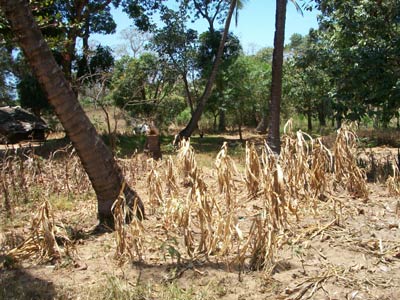
There was no potable water and to get any the women walk over a mile and pay for a pot of water which they carry back on their heads.
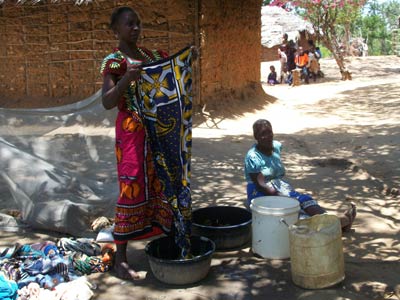
Unfortunately no advantage has been taken of the rains when they come. There was no pipeline to the village for potable drinking water. There are neither irrigation channels nor storage vats. No drainage channels to help when water cascades down the hills in freak storms.
Hygiene was and remains poor but is improving. There were no latrines not even at the school.
So we decided we wanted to help the villagers to help themselves initially:
- to improve the school and its facilities, including helping with learning aids and with the teacher’s training
- to improve the children’s diet and health
- to build a latrine and improve sanitation
- to obtain a direct pipeline for fresh potable water and begin to improve irrigation.
We thought that we were being ambitious but the enthusiasm of the villagers has overwhelmed us. More has been achieved in a few months than anyone thought possible. (Please also see, for example: Water at Last!, and Current and Future Plans)
But there is much more to do and as always: “one hill at a time”

